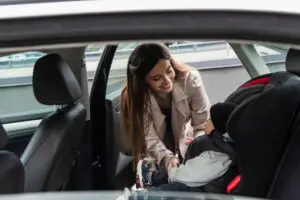When was the last time you checked your child’s car seats and their laws in the state as a parent or guardian?
It is certainly important to do as children are most at risk when it comes to accidents.
You should be well versed in car seat laws in Iowa if you either stay in the place or are planning to visit Iowa anytime soon.
Usually, children around 1-4 years are supposed to be seated in a rear-facing car seat from age 5-11.
They are supposed to be seated in a booster seat until or unless they are over 4 feet and 9 inches and above 40 pounds, where they can sit in Front after hitting 13 years of age.
If you didn’t know about these specific age-based laws, rest assured, as this article will go through all that’s needed to be prepared for seating laws.
Table of Contents
- 1 Iowa Car Seat Requirements By Ages
- 2 Car Seat Weight And Height Requirements In Iowa
- 3 Type Of Car Seat Laws In Iowa
- 4 When Is The Time For My Child To Sit In The Front Seat In Iowa?
- 5 What Happens If You Leave Your Child In A Car In Iowa?
- 6 Taxi Car Seat Laws In Iowa
- 7 Iowa Law Regarding Car Seats In Accidents
- 8 Uber Car Seat Laws In Iowa
- 9 Conclusion
Iowa Car Seat Requirements By Ages

These rules are set for children below 13; they have only been formulated to keep them safe as they are fragile beings and need protection.
Therefore proper rules and regulations have been set up to ensure that they are followed so that the safety of children is not compromised.
The article below breaks the rules and regulations into age sets for ease and comfort.
1 Year Old
If your child is 1 year old and less than 20 pounds, they must be secured in a rear-facing child seat that is the safest for their age group.
Make sure that they are safely attached to the rear seat and have no risk of falling or moving up to the undesirable case of an impact.
2 Year Old
If your child is 2 years old and is near 20 pounds of weight, you should use the rear-facing seat for the child.
3 Year Old
As your child approaches 3 years of age, and if they are below 4 feet and 9 inches, you should use the rear-facing child seat, as discussed previously.
4 Year Old
When your child hits the age of 4 and are 20-30 pounds of weight and under 4 feet and 9 inches, they will still have to use the rear-facing seat.
5 Year Old
As soon as it gets physically difficult for a child to fit in the rear-facing seat and their weight is above 30 pounds and height above 4 feet and 9 inches, you shall opt for a booster seat.
6 Year Old
At 6 years old, your child is allowed to opt for a booster seat, which would have a harness system to ensure your child’s safety.
7 – 9 Year Old
At 7 to 9 years old, the use of booster seats shall continue as previously touched upon, and necessary adjustments shall be made for the child’s comfort regarding the harness system.
10 Year Old
Regardless of your child turning 10, the child would have to remain in a booster seat, safely secured with the harness system or the seat belt in the car, depending on their height exceeding 4 feet and 9 inches.
However, some minor adjustments can be made based on the child’s comfort.
Car Seat Weight And Height Requirements In Iowa

The child must be above 4 feet and 9 inches and weigh more than 40 pounds to be shifted to a front-facing booster seat.
If the child does not meet the said requirements, they shall continue using the rear facing child seat.
Type Of Car Seat Laws In Iowa
There are different types of laws that deal with different types of seating arrangements as they keep changing based on the child’s growth, for example, their height and weight.
Therefore, the rules and regulations about those seats are not the same.
1. Rear Facing Car Seat
This is best suited for children under 6 years of age, and this is the safest option anyone could opt for when a child is mist fragile, as the impact of an airbag can be fatal for them.
Therefore, it is the safest bet to use these seats when the child is young as they would be kept most safe and secure.
2. Forward Facing Car Seat
These sorts of seats are best used after a child is over 6. They should come with a built-in harness system to ensure your child’s well-being.
These seats will keep your child boosted and upright along with proper support and belts that would keep them properly restrained.
3. Booster Seat
These booster seats, as the name implies, are simply used to boost your child upwards so that they have a comfortable driving experience while seated normally with the regular seat belt.
Though this isn’t as safe as the previously discussed methods of seating for children, it most certainly does provide a level of safety for the child and is best for them to use before switching to a normal seating arrangement.
When Is The Time For My Child To Sit In The Front Seat In Iowa?
Your child can come to sit beside you in the front seat as soon as they reach the age of 13.
However, keeping them in the rear is recommended as it is the safest for them regardless of their age bracket and their growth.
What Happens If You Leave Your Child In A Car In Iowa?
There are no such laws formulated around this subject.
However, it is to be noted that if you were somehow deemed responsible and were prosecuted, you can be charged with negligence.
Though there might be no such laws around this area of interest, it is in the best interest of parents to not leave their children alone in a car unsupervised, as it might end up harming them and putting them in distress since children are young and fragile, they must be protected at all costs.
The slightest heat within the car or distress can cause damage to a child.
Therefore, it is best to keep your child with you and under supervision if you were to run for a quick errand nearby.
Taxi Car Seat Laws In Iowa
Taxis are not responsible for enforcing laws. It is parent’s responsibility. According to the law, the parents are responsible for the negligence instead taxi drivers.
Therefore it is important to note that the parents or guardians would have to bring their child’s booster seat or rear-facing constraining seat to ensure their safety in case anything goes wrong.
Iowa Law Regarding Car Seats In Accidents
So far, there are no notable laws regarding accidents or car crashes and the seat that can be damaged during that crash.
The safest bet a person can make is to immediately change the car seat and get a new one as soon as possible, as it might have been damaged in the crash.
Furthermore, even if no visible scratches are seen, the seat must be replaced, as it could have been damaged internally, and the integrity could be at fault.
It is immensely important to keep your child’s safety at the utmost priority; therefore, these changes should be made as soon as anyone can make them.
Uber Car Seat Laws In Iowa
According to Iowa law, Uber, Lyft, and taxi drivers will not be penalized if they fail to use child restraints.
The unrestrained child’s parent or guardian will be ticketed if the automobile is pulled over.
Therefore, as previously stated, the parent has to bring their child restraint seats or their booster seats to ensure the safety of their child and to ensure that they are protected at all costs from the authority and the risk of their children experiencing any sort of injury that may be caused due to unfortunate circumstances.
Conclusion
After completion 0f this article, you should have a firm grasp of all the regulations of Iowa car seat laws.
However, in some places, they might be a little strict and may require proper care and attention.
It is extremely important to note that all these rules and regulations have been set strictly for the safety of your child and you.
This should be followed with utmost care so that your child’s well-being is not at risk and you stay clear from breaking the law.

I am Tahir Azam, and I have been writing amazing articles for TaxiHack for as long as I can remember. I know everything that is to know when it comes to automobiles and is always on top of industry news and developments. While I am not an expert by any means, I pride myself on knowing the ins and outs of many different problems and, of course, their solutions. The articles on our website are some of the best and well-researched content that you will find, and I spend countless hours making sure this remains to be true. This is why I ask you to take your time out and read some of my articles, especially if you find a topic that resonates with you or is something you are looking into. This way, you will find the perfect mix of information and tips on your desired topic. Learn more about Tahir.




